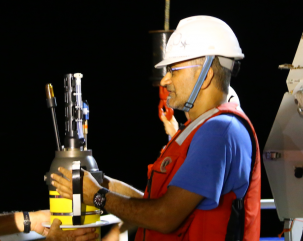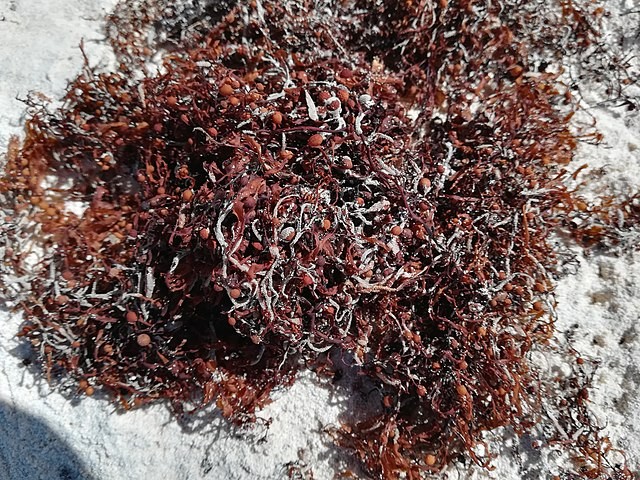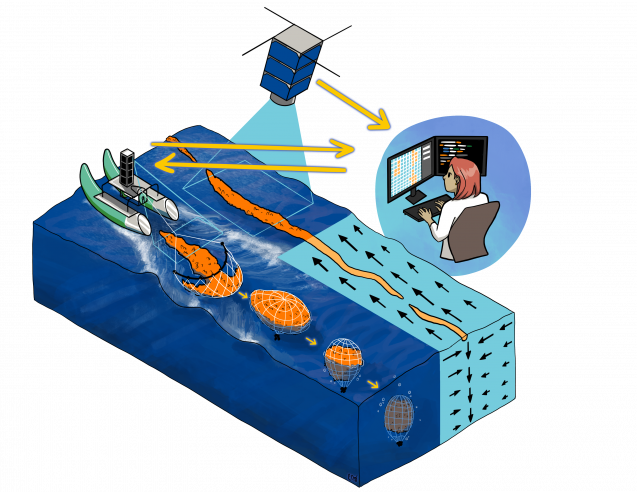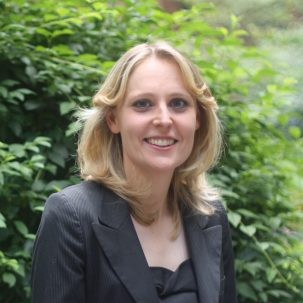What Is Blue Carbon and How Can It Help Fight Climate Change?
Researchers at Columbia Climate School discuss the benefits and challenges of working with carbon from ocean and coastal ecosystems.
Blue carbon is becoming an increasingly popular term, but what exactly does it mean? The answer may vary slightly depending on who you ask. But broadly speaking, according to the National Ocean Service, “blue carbon is simply the term for carbon captured by the world’s ocean and coastal ecosystems.”
So why is it important? And what role can it play in addressing climate change? To find out, we talked to Columbia Climate School researchers Dorothy Peteet, Ajit Subramaniam, and Romany Webb about just some of the opportunities and challenges to working with carbon from ocean and coastal ecosystems.
Protecting and Leveraging Blue Carbon
Scientists are exploring blue carbon in two main ways. First, they want to measure and preserve the carbon that’s already stored in the oceans and coastal wetlands, such as marshes and mangrove forests. Second, they want to know how we might leverage these ecosystems to mitigate climate change.
Dorothy Peteet, a senior research scientist at NASA/Goddard Institute for Space Studies and adjunct professor at Columbia University’s Department of Earth and Environmental Sciences, is trying to solve the first riddle. She and her colleagues at Lamont-Doherty Earth Observatory are measuring the carbon content in the sediments of local marshes.
“Salt marshes store about 50 times more carbon than terrestrial forests, despite their relatively small area,” she said. “This carbon is at risk with sea level rise, and will contribute to atmospheric greenhouse gas heating if the marshes are flooded.”
Looking above the sediments, Subramaniam, a research professor and oceanographer at Columbia Climate School’s Lamont Doherty Earth Observatory, focuses on the organisms living in these ecosystems and their ability to store carbon. “There is a lot of carbon stored in the stocks, seagrasses, and microalgae in the ocean and growing along the coast. So you want to make sure that any coastal development or building or human activities, such as shrimp farming or aquaculture, don’t end up releasing this carbon,” he said.
Studies have shown that wetlands store between 20 and 30% of the world’s carbon, which is particularly impressive compared with the relatively small land surface they cover.

Protecting the wetlands with captured carbon is vital, but we can’t stop there, Subramaniam continued, noting that the arguably more important way we think of blue carbon is with the goal of drawing carbon out of the atmosphere.
“As you go offshore, many of the proposed plans to remove carbon from the atmosphere start with growing kelp—which draws down carbon dioxide during photosynthesis—and then harvesting it. And here again, you have divergent pathways you can take: You can consume or repurpose the kelp. Or you can sink and bury it in a durable way,” he said.
Subramaniam believes repurposing kelp—in the form of food or biofuel—is not a sufficient approach to address the urgency of climate change, since the carbon would return to the atmosphere once the kelp is consumed or burned. “If you think of green biodiesel, it’s great and one more way to bend the emissions curve downward. But it’s not going to actually reduce the rate of emission or the amount of carbon in the atmosphere.” This is a first step, but “replacing diesel with biodiesel” can’t be the end goal, he said.
The other option, then, is to sink the kelp deep in the ocean for at least 100 years so that the carbon captured by photosynthesis does not go back into circulation in the atmosphere, Subramaniam said. Ideally, over the course of that century, you’ve also bought scientists and engineers time to come up with new and better technologies.
“We already have models that help us figure out how deep we need to sink the carbon and for how long it’ll stay there. But when you do this, you’re impacting a different ecosystem, which needs to be considered, too,” he said.
‘A Nature-Based Solution’
For one of his current projects, Subramaniam is proposing what he calls “a nature-based solution” for carbon removal that takes Sargassum macroalgae and sinks it down to 2,000 meters below the ocean’s surface. Sargassum is a pelagic macroalgae, which means it spends its entire lifecycle on the surface of the ocean and is visible to the eye. “It’s never attached to land and doesn’t come onshore unless it’s washed up and beached.”

While this macroalgae has been recognized for centuries, in just over the last 10 or 20 years, there’s a new population growing much closer to the equator, Subramaniam said. “They call it the ‘Great Sargassum Belt,’ essentially extending from the West African coast all the way to the Mexican coast through the Gulf of Mexico in the Caribbean. It’s a major nuisance.”
This kelp is piling up on beaches in the Windward Islands of the Caribbean and devastating their economy, which is largely dependent on tourism, he added. “How do you get rid of it? You can’t bury it. You can’t take it off the beaches and put it anywhere on land because the islands are too small.”
Instead, Subramaniam and his colleagues are hoping to use advanced technology including remote sensing, artificial intelligence, and marine robotics “to drive a series of platforms that are pulling nets behind them about 15 or 20 miles offshore to capture the Sargassum before it comes to the beach.”

Once a net is full of this macroalgae, it is built to break, he explained, and when this happens, there is a fastener on the net designed to close it off. The fastener has a weight attached, which will then sink this Sargassum down to 2,000 meters, meaning “we’d be taking this carbon out of circulation completely,” he said.
“There are about 1 million metric tons of carbon in this ‘new’ Sargassum population,” Subramaniam said. As a conservative estimate, he believes they can sink at least 10% of this carbon using the proposed technology, or about 100,000 metric tons a year. “For context, the Orca facility in Iceland, the largest carbon capture plant, has the capacity to pull 4000 metric tons per year from the atmosphere.”
Of course, one of the important points to consider when proposing a method like this one is the carbon life-cycle analysis. “You can’t expend 100 kilograms of carbon to sink 10 kilograms of carbon, for example. We need to make sure the amount of carbon we expend in sinking it is not more than the carbon we sink,” he said. They hope the use of remote sensing and robotic and artificial intelligence will maximize efficiency.
Subramaniam noted that he is personally “deeply suspicious of geoengineering,” but because the Sargassum population in question is new—and thus likely already connected to human activity and climate change—he feels comfortable with its removal.
He is also working with Webb, associate research scholar at Columbia Law School and deputy director of the Sabin Center for Climate Change Law, to look into the legal aspects of this process, since it falls within gray areas of existing environmental laws.
Legal and Social Considerations

“I think there are a lot of unanswered scientific questions about the role of blue carbon in mitigating climate change,” said Webb, who spends a lot of her time considering the techniques that remove and store carbon dioxide from the atmosphere, and the frameworks meant to ensure they occur in a safe and responsible way.
But along with the scientific questions, there are also social and governance issues that could affect whether we can make effective use of any proposed strategies, she added. “We may have social or public opposition to projects because they’re seen as being unnatural or as interfering with the ocean ecosystem, which many view as the last untouched part of the Earth, or because they’re seen as affecting other ocean-based activities. Some groups have also expressed concern that, because projects would take place in the ocean, which is part of the global commons, they may be subject to limited oversight and control by national governments.”
While a large body of international law applies to ocean-based activities, there is no comprehensive international legal framework that deals specifically with ocean carbon removal techniques, she said, leading to a lot of uncertainty. For example, ocean fertilization and ocean alkalinity enhancement, where you’re adding substances to the water, could be viewed as a form of ocean dumping, which has an established international legal framework.
“That framework, however, was developed to address things like dumping oil into oceans,” she said. Plus, as Subramaniam points out for his project, “in this case you’re taking what’s already in the ocean and moving it to a different place.”
Another challenge, Webb added, is that the closer you get to shore, the more likely there are to be domestic laws, creating potentially overlapping frameworks. “In the U.S. specifically, domestic laws can include multiple layers of government because you might have federal, state, and even local laws. So there’s a lot of complexity and uncertainty about how different activities will be treated and how they will fit into existing frameworks that were not really developed for carbon removal.”
Next Steps
Webb and her colleagues at the Sabin Center are currently working on a book that examines these existing international and national legal frameworks, and how they apply to different ocean-based carbon removal activities. In addition to studying U.S. laws, they are also working with legal academics from six other countries (China, Canada, Germany, Norway, the Netherlands, and the U.K.). The book—titled Ocean Carbon Dioxide Removal for Climate Mitigation: The Legal Framework—will be published this spring.
At the same time, Webb and her colleagues at the Sabin Center are also writing a set of model laws for ocean carbon dioxide removal projects. “We want to draft model legislation that could be enacted by Congress to create a comprehensive legal framework specific for ocean carbon dioxide removal research,” she said. The areas covered by this document would include: the scope of federal jurisdiction over ocean carbon dioxide removal projects, whether responsibility to oversee this research is entirely federal or if the states will have a role to play, which agencies should issue permissions and what factors they will need to consider in doing so, as well as what the environmental review and public consultation process should look like for research projects.
“We expect to publish a draft of the model legislation early in 2023,” Webb said.
Through initiatives like these, experts hope to bring more clarity to the growing field of blue carbon research—for scientists, lawmakers, and the general public.
